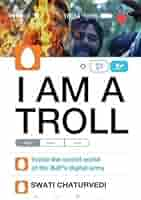In the age of digital democracy, political power is as much about
perception as it is about policy. No party in India has understood—and
exploited—this reality better than the Bharatiya Janata Party (BJP). At the
centre of its electoral juggernaut lies a carefully engineered, tightly
coordinated, and ideologically committed force: the BJP/RSS IT Cell.
The hypothesis that dismantling this IT infrastructure could destabilize or
even "finish" the BJP is not merely a provocation—it invites a deeper
examination of how information ecosystems, online propaganda, and narrative
warfare have reshaped Indian politics. To understand the extent of this digital
grip, one must dissect the genesis, functioning, and impact of this formidable
machinery.
The BJP IT Cell was founded in 2007 by Prodyut Bora. During the campaign
for the 2004 Indian general election, the BJP had already promoted the India
Shining slogan and used around 5% of its campaign budget on texts and
pre-recorded phone calls to reach voters. The BJP orchestrates online campaigns
through its social media cell to intimidate perceived government critics.
Sadhavi Khosla, https://caravanmagazine.in/vantage/sadhavi-khosla-bjp-social-media-trolls a BJP cyber-volunteer in the BJP IT Cell, said that the
organisation disseminated misogyny, Islamophobia and hatred. The network of
volunteers of BJP take instructions from the BJP IT Cell and two affiliated
organisations to troll users who are critical of the BJP. Journalists and
Indian film actors are also among their targets.
Swati Chaturvedi’s explosive book I Am a Troll pulls back the
curtain on this digital war room. Drawing on firsthand testimony, it exposes
how Hindutva’s digital foot soldiers manufacture consent, silence dissent, and
spread venom under the veneer of patriotism. The book offers rare insight into
the coordinated machinery behind the façade of spontaneous online support,
revealing the orchestrated hypocrisy behind self-proclaimed nationalist
trolling.
In November 2015, Aamir Khan, an Indian Muslim actor, expressed concern
about rising intolerance in India in response to political events that included
violent attacks against Muslims and intellectuals, and the absence of swift or
strong condemnation from the country's ruling BJP government. Khosla said that
BJP responded with an online campaign through its social media cell to
intimidate Khan. Modi supporters bombarded the company where Khan was
spokesperson with orders and later cancelled them, resulting in the company
distancing itself from Khan, though a planned boycott of his film Dangal
by BJP supporters proved unsuccessful. Derek O'Brien, a member of Parliament,
raised the topic of online hate in the Rajya Sabha. He questioned why Narendra
Modi followed cyber-bullies on social media and said, "We are
mainstreaming hate". He also asked if the Modi administration would issue
an advisory asking government officials to stop following Twitter users that
regularly send abusive messages and obscenities. The government did not respond
to this request.
In December 2020, Twitter took restrictive action against Amit Malviya, IT
Cell in charge, and tagged his posts as 'manipulated media'. This was the first
time Twitter took restrictive action against an Indian political personality.
Malviya had posted an edited video of an incident from the 2020–2021 Indian
farmers' protest that violated Twitter policy towards fighting the spread of
doctored media.
An investigation by the Indian media watchdog Newslaundry revealed
the organisational structure of the IT Cell: The state IT cell has 25 members
in the core team with Rai as its head. Each regional centre had 20 members and
a team of 15 handled IT at each of the 92 districts. Seven-member teams worked
at the block levels. At the regional, district and Assembly level, BJP had
approximately 5,000 workers. A separate team of 20 professionals – including
technicians, designers, and cartoonists – created the desired content for the
party.
JPS Rathore, a member of the UP-BJP's IT Cell described the motives of the
organisation as follows:
"Our aim was to capture the mind of the voter. To message them night
and day. Whenever they look, they should see us, hear our message. (Humari
rajniti thi ki chunav ke pehle voter ke dimag ko capture kar lo. Subeh–shaam
message bhejo. Jab dekhe, humara chehra dekhe, humari baat sune)."
The BJP’s IT Cell is not a conventional public relations team. It is a
hybrid of a media company, a political war room, a troll factory, and a
propaganda engine. Staffed by full-time professionals and supported by an army
of volunteers and sympathizers, the IT Cell is organized in a hierarchical
fashion—much like a paramilitary force. Every message, meme, and talking point
is part of a broader narrative strategy.
From the national headquarters in Delhi to WhatsApp groups at the booth
level, the digital operations of the BJP are both top-down and hyper-local.
They deploy micro-targeting techniques using voter data, behavioral analytics,
and caste/religious demographics to tailor their content to specific audiences.
This is not just communication—this is psychological warfare.
Speed is everything in digital politics. The IT Cell specializes in
flooding platforms with content the moment a controversy breaks. While the
opposition drafts a press release, the BJP's ecosystem already has a dozen
memes, hashtags, and viral videos in circulation. These are amplified by
influencers, fake accounts, bots, and media channels aligned with the ruling
ideology.
The emphasis is not on truth but on traction. A lie that trends becomes a
truth in perception. By the time it is fact-checked, it has already served its
purpose.
The BJP’s digital strategy transcends mere storytelling. It is about
defining what counts as reality. Whether it's rewriting historical narratives,
distorting opposition statements, or creating fear about minorities, the IT
Cell manufactures consent and outrage with industrial efficiency. WhatsApp
forwards that mix half-truths with communal innuendo have become a key mode of
voter persuasion in rural India.
The cumulative effect is toxic: polarization, disinformation, and an
erosion of trust in journalism, institutions, and even science. Critics are
routinely targeted through doxxing, trolling, or worse—often backed by
semi-official dog whistles.
No political figure has benefited more from digital myth-making than
Narendra Modi. The IT Cell has elevated him from a regional leader to a
cult-like global statesman. His image—carefully curated, selectively
photographed, and algorithmically promoted—is the crown jewel of the BJP’s
digital empire.
Criticism of Modi is not treated as political disagreement but as heresy.
This deification, enabled by relentless digital campaigning, has created a
leader beyond reproach—a dangerous condition in any democracy.
Elections in India today are as much about mobilizing narratives as
mobilizing voters. The BJP’s IT Cell has played a crucial role in shaping the
outcome of almost every major election in the last decade—from Uttar Pradesh
and Bihar to Assam and Karnataka.
The key lies in narrative control. Whether it's invoking nationalism after
Balakot, spinning economic data post-demonetization, or justifying lockdown
chaos during COVID-19, the IT Cell has turned crisis into opportunity through
rapid reframing.
Would the BJP collapse if its IT Cell were dismantled? Not instantly. The
party has deep-rooted ideological bases, a strong organizational network (the
RSS), and powerful funders. But it would lose its greatest strategic advantage:
the ability to control perception in real time.
In a post-IT Cell landscape, the BJP would have to confront unfiltered
public opinion, media scrutiny, and grassroots backlash without the shield of
curated narratives. Opposition voices would regain space. Independent
journalism could flourish. Civil society would breathe freer.
In short, the party would have to do politics the old-fashioned way: with
accountability.
The conversation is not merely about one party. The BJP's IT Cell is the
model now being emulated by regional parties, corporate lobbies, and even
foreign actors. It represents the broader crisis of digital democracy: where
the speed of lies outpaces the slowness of truth.
To destroy the BJP’s IT Cell is not to silence a party, but to dismantle a
machine that has subverted democratic deliberation. It is to restore balance to
a public sphere overwhelmed by hate, hyperbole, and half-truths.
Every empire has its Achilles' heel. For the BJP, it is its digital
invincibility. Strip away the algorithms, expose the misinformation, and the
party is forced to stand on the merit of its policies and the integrity of its
governance.
This is not a call for censorship but for civic resistance—a pushback
against a weaponized narrative industry. Until then, the BJP's IT Cell remains
its greatest asset—and Indian democracy's most urgent challenge.
In the digital age, the BJP’s IT Cell operates as the nerve centre of its
political power—crafting narratives, spreading disinformation, and weaponizing
social media to manufacture consent and crush dissent. From micro-targeted
propaganda to coordinated trolling armies, this machinery distorts reality,
fuels polarization, and elevates a cult-like mythology around Narendra Modi.
While deeply rooted in organizational strength, the BJP’s strategic dominance
hinges on controlling perception online. Exposing and dismantling this network
is essential not just to challenge one party, but to reclaim the integrity of
Indian democracy itself.
The BJP’s digital war room is more than just a campaign tool—it’s the
algorithmic fortress that shields a fragile political empire built on curated
myths and manufactured outrage. To unplug this machine is not to silence a
voice but to revive a democratic discourse smothered under waves of digital
deceit. Until then, the IT Cell remains the Sangh’s most lethal weapon,
rewriting India’s narrative with a click and a troll. It’s time for citizens,
journalists, and institutions to reboot their resistance—not with censorship,
but with relentless fact, fearless accountability, and unyielding truth.
Because in the kingdom of digital hate, only an awakened electorate can break
the code.
About the Author
Siddhartha Shankar Mishra is an Advocate at the Supreme Court of India. He
writes on law, politics, and society with a voice that blends satire and truth.




No comments:
Post a Comment